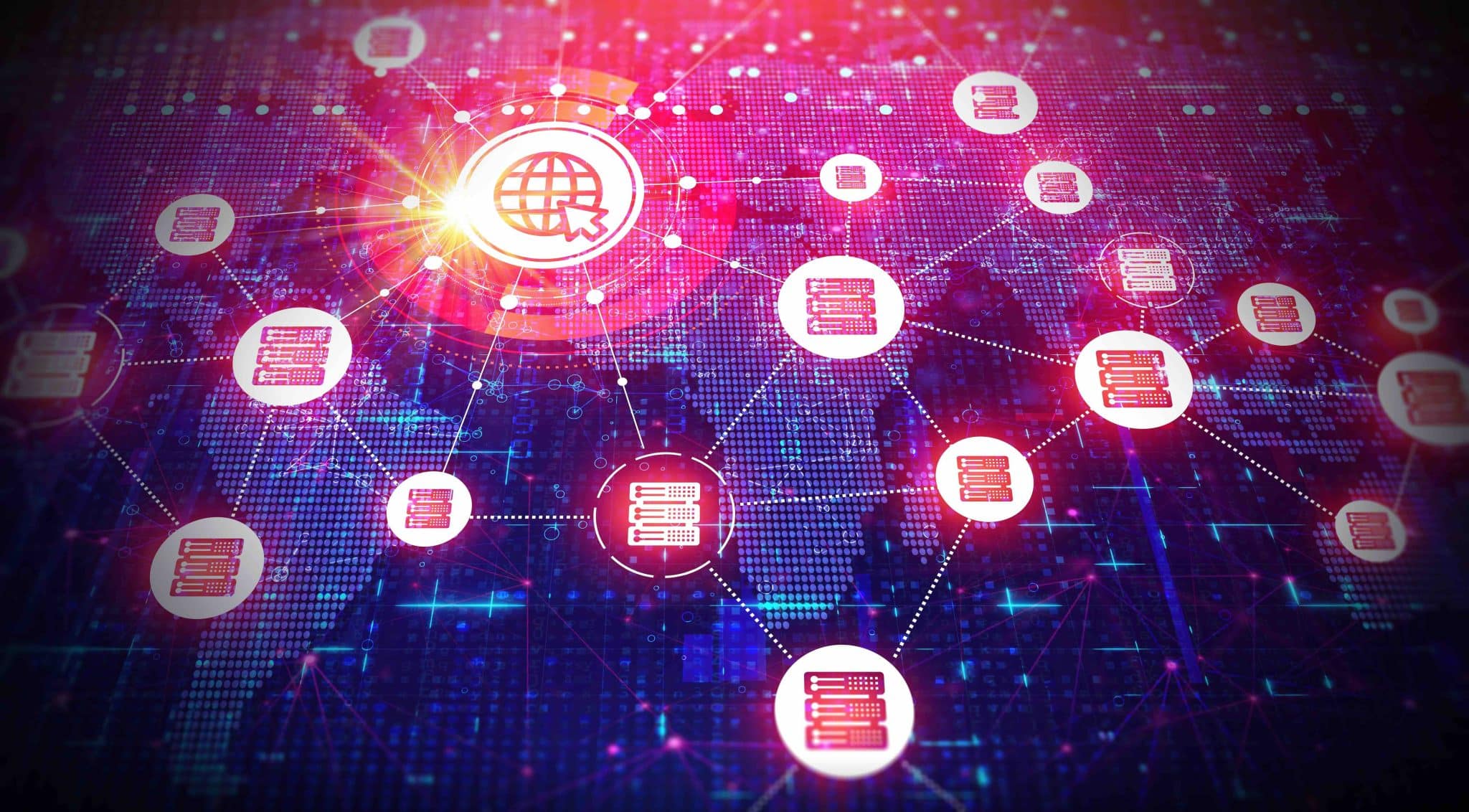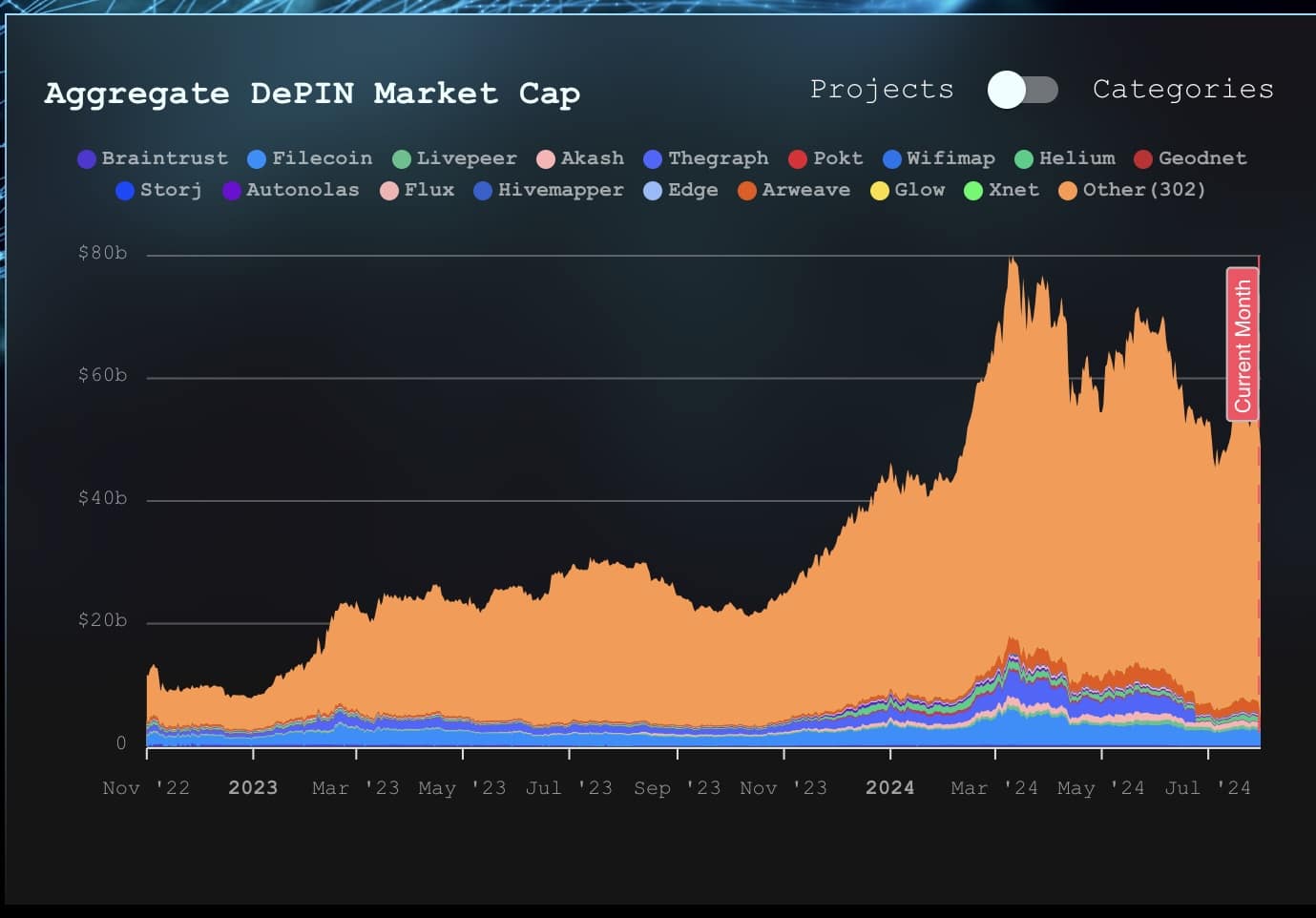DePIN Crypto is About to See Explosive Growth! Don’t Miss It!
DePIN (Decentralized Physical Infrastructure Networks) is an emerging Web3 sector that brings blockchain technology and decentralization principles to physical systems. This concept extends the benefits of decentralization beyond digital spaces, like DeFi and NFTs, to tangible infrastructure, such as IoT (Internet of Things) projects.
DePINs use technologies such as smart contracts and blockchain to facilitate autonomous and real-time interactions within physical infrastructures, enhancing their responsiveness and adaptability.
Key Highlights
- With the help of blockchain technology, Decentralized Physical Infrastructure Networks (DePINs) are changing how physical infrastructure is built and managed.
- By using DePINs, building, and managing infrastructure becomes cheaper and more efficient than previous methods.
- Through DePIN, people can make money by offering their own resources to be part of the network, being rewarded for contributing to the network.
- The rise of these DePIN projects has led to a big boom in this promising sector.
- Thanks to a significant increase in venture capital investment and future potential, more investors are investing in DePIN projects now.
- DePINS could really shake things up in several fields, such as entertainment, internet, mapping technology, data storage, GPU rendering, energy, and more.
DePIN Crypto is About to Explode: Article Summary
DePIN (Decentralized Physical Infrastructure Networks) is set for rapid growth by bringing blockchain technology to physical systems like IoT, renewable energy grids, and supply chains. Projects such as Helium, Wicrypt, Render Network, BitTorrent, Filecoin, Arweave, Theta Network, MultiverseX, Ocean Protocol, Livepeer, Storj, and Helium are notable examples revolutionizing various sectors through decentralized, efficient, and transparent solutions.
The Emergence of DePIN Technologies
This year marks a pivotal shift for Decentralized Physical Infrastructure Networks (DePINs), as manufacturers increasingly integrate blockchain technology with real-world infrastructure. The DePIN market, currently valued at $2.2 trillion, is projected to reach $3.5 trillion by 2028. Significant venture capital investments from firms like Pantera, Multicoin Capital, and Coinbase reflect the growing interest in DePINs. This enthusiasm stems from DePIN’s revolutionary approach to infrastructure ownership, utilizing blockchain protocols and cryptocurrency tokens to incentivize the creation and operation of decentralized infrastructures, promising to transform both digital and physical spaces over the next five years.
While blockchain initially focused on digital assets like Bitcoin and speculative investments, DePINs showcase its potential to impact everyday life. By using blockchain, DePINs enhance security, efficiency, and transparency in physical systems, such as renewable energy grids and supply chains. They can provide unalterable records of product origins, ensuring authenticity and transparency, and enable peer-to-peer resource trading, democratizing access to resources.
Integration with renewable energy supports sustainable blockchain operations and reduces environmental impact. Additionally, decentralized autonomous organizations (DAOs) play a crucial role in DePINs by allowing stakeholders to collaboratively govern and develop these networks. This article will explore the DePIN space, what this emerging sector will mean for the market, and its future direction.
Despite being in its early stages, DePIN is boosting ecosystems that prioritize equitable participation, transparency, and shared ownership. Early examples, such as Helium’s decentralized internet access and Wicrypt’s tokenized wireless infrastructure, showcase the transformative potential of DePIN. These platforms democratize connectivity and data sharing, offering affordable and accessible services. In the EV charging industry, DePINs facilitate the development of decentralized charging networks, ensuring broader access and reducing the risk of monopolies. While challenges like regulatory hurdles and price volatility persist, robust protocols and incentive mechanisms can help mitigate these issues. The rise of DePIN signals a shift toward more secure, efficient, and decentralized infrastructure systems.
Understanding DePIN
So, how exactly does DePIN technology work?
DePIN networks integrate physical assets like communication towers and sensors with digital nodes to capture data, creating a seamless, decentralized ecosystem. There are already DePIN projects collecting data for things like local weather, sharing internet, collecting location data similar to Google Maps, sharing GPU power to power virtual worlds, and more.
Core Features of DePIN Networks
- Interconnected Infrastructure: DePIN networks connect physical infrastructure components to a decentralized network for efficient data sharing and management.
- Blockchain Integration: Using blockchain technology, DePIN networks ensure transparency, security, democratization, and immutability in managing physical assets.
- Decentralization: Operating without central authorities, DePIN networks distribute control across participants, enhancing reliability and resilience.
- AI Integration: DePIN also has the potential to help bring improvements to the AI space due to the sector’s massive power consumption and could help facilitate decentralized solutions. Curious to learn about how crypto and AI benefit each other? You can read about that in our article on Crypto and AI.
Benefits of DePIN
What are the benefits of the DePIN technology? DePIN offers numerous advantages that include enhanced efficiency, improved security, scalability, and increased resilience, making DePIN a transformative solution across various sectors. Let’s talk about them.

Enhanced Efficiency: DePIN enhances efficiency improving operational processes, reducing manual intervention and errors. This streamlines operations and significantly lowers operational costs.
- Streamlined Operations: DePIN can automate many operational processes through smart contracts to reduce manual intervention and errors.
- Cost Reduction: By eliminating intermediaries and optimizing resource allocation, DePIN can significantly lower operational costs.
- Real-Time Data Access: Provides immediate access to data across the network, enabling quicker decision-making and response times.
Scalability: Scalability has proven to be the “Achilles Heel” for nearly every blockchain network, known as the Blockchain Trilemma. The trilemma states that each blockchain needs to choose tradeoffs between scalability, centralization, and security. DePIN projects may be able to help with this.
- Modular Architecture: DePIN networks can be designed with modular components.
- Interoperability: Supports seamless communication and interoperability between different systems and networks.
- Resource Optimization: Dynamic allocation of resources based on demand ensures efficient use of infrastructure.
Resilience: Susceptibility to attacks is a high-priority issue in any technology. DePIN can reduce this.
- Fault Tolerance: Decentralized systems are less prone to complete failure as the network can continue to operate even if some nodes go offline.
- Disaster Recovery: In case of disasters, the decentralized nature allows for quicker recovery and restoration of services.
Transparency and Trust: They said we needed trust to move the world forward. Blockchain technology said it could eradicate the need for trust and it has done so. DePIN is also building on this.
- Auditability: All transactions and changes to the network are transparently recorded on the blockchain.
- User Confidence: Increased transparency builds trust among users and stakeholders.
Innovation and Collaboration: How will DePIN foster innovative and collaborative endeavors?
- Open Source Development: Encourages innovation by allowing developers to build on existing infrastructure and collaborate on improvements.
- Community Governance: Enables community-driven decision-making processes.
Environmental Impact: There are downsides to every technological advancement. Crypto mining consumed so much power that the CBECI estimates that global electricity consumption for Bitcoin mining in 2023 varied between 67 TWh and 240 TWh, with an average estimate of 120 TWh. Additionally, Bitcoin mining generates over 77 kilotons of electronic waste annually. How will DePIN jump this hurdle?
- Efficient Resource Use: Optimizes the use of physical resources, potentially reducing waste and energy consumption.
- Sustainable Practices: Encourages the adoption of sustainable practices through transparent and accountable processes.
Flexibility and Customization: DePINs offer flexibility and customization by allowing tailored frameworks and custom protocols to meet the specific needs of various industries and applications.
- Adaptable Framework: Can be tailored to meet the specific needs of different industries and applications.
- Custom Protocols: Supports the development of custom protocols and standards.
Potential Use Cases of DePIN Cryptocurrencies
DePIN cryptocurrencies have a wide range of applications, transforming industries by enhancing efficiency, security, and transparency. From smart cities to environmental monitoring, these decentralized networks are revolutionizing how we manage and interact with physical infrastructure.
Smart Cities: DePIN revolutionizes smart cities by providing decentralized solutions for managing and optimizing traffic, energy, and waste systems.

- Traffic Management: Real-time optimization of traffic flow through decentralized data collection from vehicles.
- Energy Grids: Smart grids using DePIN to balance supply and demand, integrating renewable energy sources.
- Waste Management: Smart bins and waste collection systems optimizing routes and schedules based on real-time data.
Environmental Monitoring: DePIN advances environmental monitoring by deploying decentralized networks for real-time tracking of wildlife, air quality, and environmental conditions.
- Wildlife Tracking: Distributed tracking devices incentivizing citizens to maintain and monitor wildlife.
- Forest Fire Prevention: Sensors distributed in at-risk areas to detect early signs of fires.
- Air Quality Monitoring: Decentralized air quality sensors providing real-time data to improve urban health policies and decisions.
Telecommunications: DePIN improves telecommunications by enabling decentralized management of networks for enhanced disaster resilience, rural connectivity, and efficient 5G deployment.
- Disaster Resilience: Robust communication networks that remain operational during natural disasters.
- Rural Connectivity: Incentivizing mesh networks in remote areas to bridge the digital divide.
- 5G Deployment: Optimizing the rollout and management of 5G infrastructure through decentralized coordination.
Energy Management: DePIN optimizes energy management by integrating distributed resources, facilitating demand response, and enabling efficient peer-to-peer trading of renewable energy.
- Virtual Power Plants: Aggregating distributed energy resources into virtual power plants, optimizing grid stability.
- Demand Response: Creating a flexible grid by incentivizing users to adjust their energy consumption based on real-time supply and demand.
- Renewable Energy Trading: Facilitating peer-to-peer trading of excess renewable energy.
Supply Chain Management: DePIN enhances supply chain management by providing decentralized tracking of provenance, real-time inventory monitoring, and streamlined logistics coordination.
- Provenance Tracking: Ensuring the authenticity and origin of products through decentralized tracking.
- Inventory Management: Real-time monitoring and management of inventory levels to reduce waste.
- Logistics Optimization: Enhancing coordination of logistics operations through decentralized data sharing and automation.
Healthcare: DePIN transforms healthcare by securing medical data management, enabling decentralized telemedicine, and improving the tracking and verification of clinical trials.
- Medical Data Management: Secure and private management of medical records through decentralized systems.
- Telemedicine: Decentralized platforms facilitating remote consultations and medical services.
- Clinical Trials: Enhanced tracking and verification of clinical trial data through decentralized networks.
Agriculture: DePIN advances agriculture by offering decentralized solutions for crop monitoring, enhancing supply chain transparency, and facilitating direct farmer-to-consumer transactions.
- Crop Monitoring: Decentralized sensors providing real-time data on soil health and crop growth.
- Supply Chain Transparency: Ensuring transparency and efficiency in the agricultural supply chain from farm to table.
- Decentralized Marketplaces: Facilitating direct transactions between farmers and consumers to reduce middlemen.
Transportation and Logistics: DePIN optimizes transportation and logistics by improving fleet management, coordinating autonomous vehicles, and enhancing freight tracking and coordination.
- Fleet Management: Decentralized tracking and management of vehicle fleets to optimize routes and maintenance schedules.
- Autonomous Vehicles: Coordinating the operation of autonomous vehicles through decentralized networks.
- Freight Management: Improving tracking and coordination of freight shipments through real-time data sharing and automation.
Exploring the Top DePIN Projects of the Year
While this article focuses on the broader implications of DePINs, you can find out more about the most promising projects in our Top DePIN Crypto Projects of 2024 article. Below is a brief overview of some notable projects:
Render Network: The Render (RNDR) Network, launched by Jules Urbach in 2016, is a peer-to-peer platform that utilizes blockchain technology to democratize access to GPU rendering resources. It links users in need of rendering services with those who have idle GPUs, forming a global marketplace where unused GPU power can be monetized. The network is built on three key components: creators (those requesting GPU services), node operators (GPU owners), and OctaneRender (the rendering software). Creators submit their rendering tasks, which are then assigned to suitable GPU providers based on factors such as reputation and capacity. The providers complete these tasks and receive Render tokens as payment upon successful verification. This approach maximizes the use of GPU resources, reducing rendering costs and increasing efficiency.
BitTorrent: BitTorrent is an internet transfer protocol designed for downloading files. Unlike traditional protocols like HTTP and FTP, which download files sequentially from a single source, BitTorrent uses a distributed approach. It connects users who have the desired files and downloads pieces from multiple users simultaneously, resulting in faster download speeds. Although it accounted for a significant portion of internet traffic in the mid-2000s, its popularity declined with the rise of streaming services. TRON purchased BitTorrent in 2018, and has evolved into a fully decentralized file-sharing platform, where users are incentivized to share files using its native token, BTT. The platform supports Windows, Mac, and Android, but not iOS. Despite trading below its all-time high, BitTorrent’s market capitalization suggests potential for long-term growth.
Filecoin: Filecoin is a decentralized storage network designed to provide a secure and efficient way to store and retrieve data using a distributed network of computers. It incentivizes users to offer cloud storage space by rewarding them with FIL tokens. Users needing storage space pay for it with FIL tokens, creating a sustainable, tokenized ecosystem. Filecoin, one of the leading DePIN projects, has experienced significant price volatility since its 2017 presale. The network continues to expand, focusing on adding more storage providers and enhancing interoperability with other blockchain systems. Filecoin’s mission and innovations make it a key player in the decentralized storage market.
Arweave: Arweave is a decentralized storage network designed to provide permanent and sustainable data storage using blockchain technology. Created to address long-term data storage challenges, Arweave offers a unique economic model where users pay a one-time fee in AR tokens to store their data permanently. The network’s innovative blockweave technology ensures efficient, low-energy storage by verifying only a random piece of data before adding new information, creating a 3D web of data rather than a traditional blockchain. This model supports the permaweb, a permanent and decentralized version of the internet where web pages and applications remain functional and accessible indefinitely. Arweave’s approach, combining technical and economic components, establishes it as a pioneering solution in the decentralized storage landscape.
Theta Network: Theta Network is a decentralized peer-to-peer video streaming platform that aims to solve the “last mile” delivery problem faced by traditional content delivery networks (CDNs). By incentivizing users to share their excess bandwidth and computing resources, Theta improves video streaming quality and reduces reliance on centralized data centers. The network is powered by a dual token system: THETA for governance and staking by Validator and Guardian nodes, and TFUEL for operations and rewards. Founded in 2018 by Mitch Liu and Jieyi Long, Theta has attracted significant partnerships and investments, offering a unique blockchain solution to the video streaming industry.
MultiverseX: MultiversX, formerly known as Elrond, is a blockchain protocol designed for high scalability, low transaction costs, and efficient energy use, capable of handling up to 100,000 transactions per second. It supports decentralized finance (DeFi), DePIN initiatives, and the Internet of Things (IoT) through its innovative Adaptive State Sharding and Secure Proof of Stake (SPoS) consensus mechanisms. MultiversX enables micro-transactions with an average cost of just $0.002 and leverages ZK technology for data integrity. Its native token, EGLD, is used for staking, governance, and transaction fees, though it has underperformed recently. The platform supports both online and offline applications, such as collateralized stablecoin loans and smart contract automation, offering a comprehensive and sustainable blockchain solution.
Ocean Protocol: Ocean Protocol is a blockchain-based platform designed to democratize and monetize data sharing by creating a decentralized data marketplace. Founded in 2017, it enables data owners to securely share and monetize their data using ‘datatokens’ on a peer-to-peer basis. For example, a marine wildlife research organization can tokenize its data on water quality and population numbers and sell it to interested parties using OCEAN tokens, providing an income stream for data providers. Built on Ethereum, Ocean Protocol supports secure data access without compromising ownership, crucial for AI model development in sensitive fields like healthcare and finance. Its key components include data providers, consumers, and the Ocean Market, and it features Compute-to-Data for privacy-preserving computations on datasets.
Livepeer: Livepeer is a decentralized video streaming network built on the Ethereum blockchain, designed to provide faster and more cost-effective video transcoding solutions for application developers. By distributing the computing power needed for video transcoding and hosting across a network of users, known as “video miners,” Livepeer significantly reduces costs—up to 50 times cheaper than traditional providers. These miners receive LPT tokens as rewards for contributing their GPU, CPU power, and bandwidth. Developers, in turn, pay for Livepeer’s services using LPT tokens at reduced costs. Livepeer’s decentralized framework allows anyone to become an orchestrator, earning LPT tokens by providing computational resources. Despite recent price gains of 130% over the past year, LPT tokens are still trading 87% below their all-time high, with a market cap of just under $340 million.
Storj: Storj is a decentralized cloud storage network that leverages a global network of independent nodes to offer private and secure data storage solutions. By allowing individuals to contribute unused hard drive space, Storj creates a distributed storage system that encrypts and splits data into smaller pieces, distributing these across multiple nodes to ensure security and redundancy. Users of the Storj network pay for storage with STORJ tokens, while node operators are compensated in the same tokens. This model provides a more cost-effective and environmentally friendly alternative to traditional cloud storage services. With a market cap of $207 million and a price currently trading 87% below its all-time high, Storj has seen a 49% increase in the past year, reflecting strong price momentum.
Helium: Helium is creating a decentralized ecosystem of wireless networks, including Internet of Things (IoT) and 5G, by leveraging blockchain technology to distribute network infrastructure and rewards. It operates with a dual-token system where the Helium Network Token (HNT) is used for network governance, staking, and transaction fees, while Data Credits (DC) are used to pay for data transfer within the network. Participants, known as Hotspot operators, deploy devices to provide network coverage and are rewarded with tokens. The network uses a unique Proof-of-Coverage (PoC) consensus mechanism to verify coverage and ensure the reliability of services. Since transitioning to a subDAO framework on the Solana blockchain, Helium has expanded its capabilities and grown rapidly, especially in the mobile network sector.
Other than DePIN, you can also explore The Hottest Crypto Trends for the Next Bull Run to keep on your radar.
Evaluating DePIN Investments for ROI
On June 27, Vienna-based car-sharing company Eloop, in collaboration with Peaq Network, has tokenized 100 Teslas using blockchain-based self-sovereign IDs. This blockchain integration on the Peaq Network, built on Polkadot, enhances transparency and ownership while promoting mainstream adoption of Web3 by connecting digital and real-world assets. Also, last year the German government-backed company, Bosch, showcased a blockchain-based digital mobility project at IAA Mobility 2023, featuring a peer-to-peer parking and charging scheme using moveIDs on the Peaq Network.
Why are these developments advancing at such a rate? It’s a harbinger of the economic incentives embedded in DePIN’s tech innovations.
Currently DePIN.Ninja data indicates that the DePIN ecosystem includes 1,546 projects with a combined market capitalization of $80 billion; covering sectors such as computing (250 projects), AI (200 projects), wireless (100 projects), sensors (50 projects), energy (50 projects), and services (25 projects).

CoinMarketCap (CMC) data shows that the top 10 projects predominantly focus on AI, storage, and computing. Despite this, DePIN currently holds a smaller share of the crypto market compared to sectors like Meme tokens, DeFi, and NFTs. In the traditional IoT sector, DePIN now has six projects exceeding $1B, with more than 20 in the hundreds of millions.
These figures suggest the DePIN sector’s potential profitability could increase by 243 times in the near-to-medium term and over 400 times in the mid-to-long term.
The Future Landscape of DePIN Crypto
With the integration of blockchain technology, artificial intelligence (AI), machine learning (ML), Internet of Things (IoT), and other various sectors, DePINs will drive major changes across various industries. By using decentralized networks, they offer cost-effective, efficient, and secure data storage solutions.
There is also a decent amount of investment from established players in the VC world:
“Venture capital firms like Multicoin, Borderless, A16Z, and HTX Ventures have made substantial investments in the DePIN sector, focusing on projects with robust utility and minimal speculative elements.” –Source
In the realm of wireless networks, DePINs are enabling shared platforms for IoT devices. Participants earn rewards for sharing their unused resources, promoting a more inclusive and efficient system.
In energy management, DePINs are facilitating the use of renewable sources and decentralized energy sharing. Participants can share excess energy from batteries or renewable sources, earning cryptocurrency tokens as rewards. This approach not only supports sustainability but also creates new revenue streams for participants.
See Also: Top 10 DePIN Coins to Invest in 2024
FAQs
What Makes DePIN Different from Other Crypto Technologies?
DePINs apply blockchain technology to physical infrastructure, decentralizing management and operations. Compared to traditional methods, this approach enhances efficiency, reduces costs, and increases security.
How Can Beginners Start Investing in DePIN Projects?
Beginners should research various DePIN projects, evaluate their potential, and understand the risks involved. Essential steps include investing through reputable platforms and staying informed about market trends.
What Are the Risks Involved in DePIN Investments?
DePIN investments carry inherent risks due to market volatility and the technology’s nascent stage. Thorough research and risk assessment are crucial for making informed investment decisions.
Can DePIN Crypto Projects Ensure Better Privacy and Security?
Yes, DePIN projects enhance privacy and security by decentralizing data storage and management. This reduces the risk of data breaches and ensures greater reliability and control over information.
Where to Find More Information on Upcoming DePIN Projects?
For more information on upcoming DePIN projects, visit reputable cryptocurrency news sites, industry forums, and project websites. Engaging with the community and staying updated on industry developments is also beneficial.
References:
Schulman, Aaron, et al. “Helium: A Decentralized Wireless Network for the Internet of Things.” *University of California, San Diego*, https://cseweb.ucsd.edu/~schulman/docs/imc21-helium.pdf.
peaq. “100 Teslas on peaq: ELOOP Brings Car Sharing to the Economy of Things.” peaq, 25 Apr. 2023, www.peaq.network/blog/100-teslas-on-peaq-eloop-brings-car-sharing-to-the-economy-of-things.
“Analytics.” depin.ninja, www.depin.ninja/analytics.


